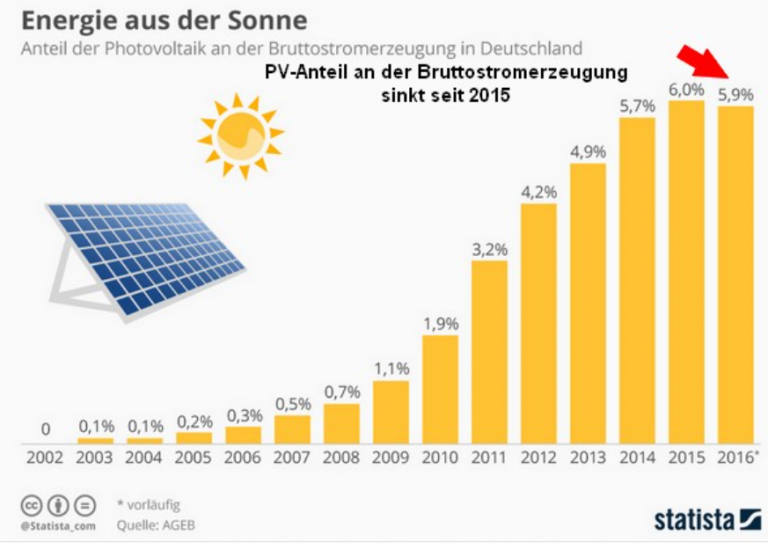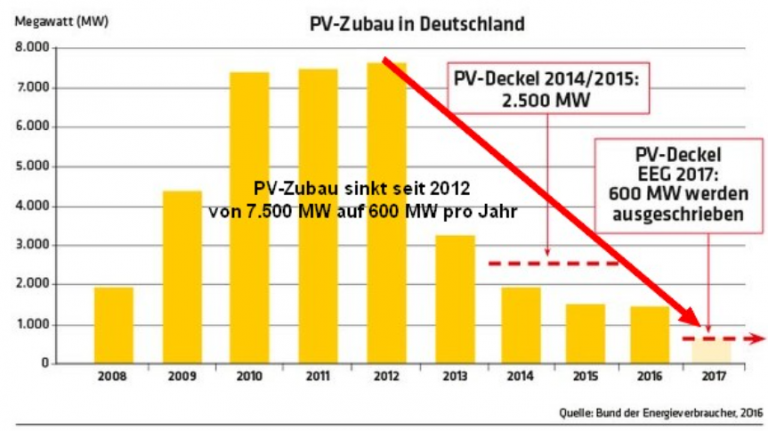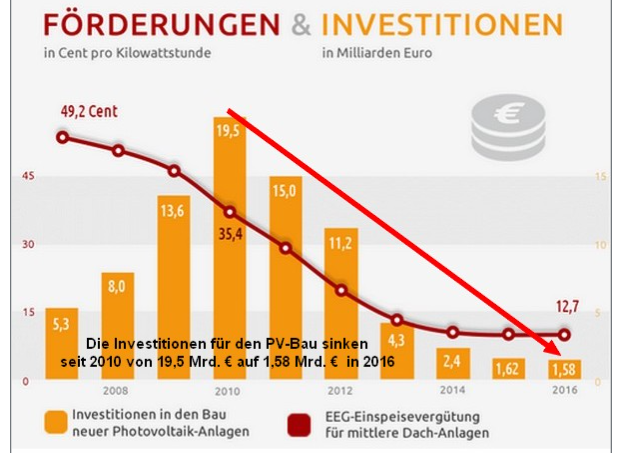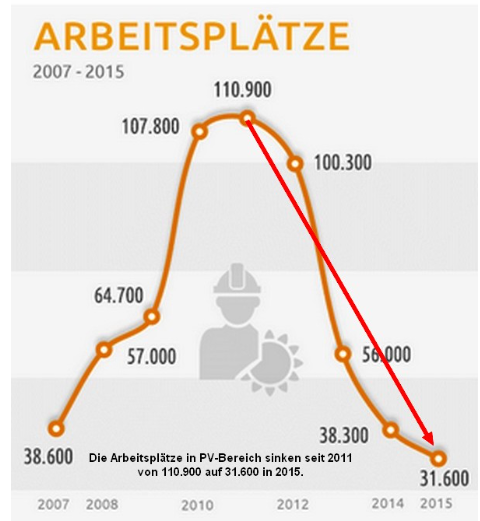Michael Kruger at German skeptic site Science Skeptical here writes about how solar energy indutry in Germany has disintegrated spectacularly.
What follows are 4 charts that show us some shocking trends, and how in reality the German solar industry has seen a bloodbath that can be rated as one of the worst in a long time. The reality is that Germany’s green revolution is far from being a model for the world.
Solar share of electricity falls
The first chart shows solar energy as a share of gross electricity production:
Share of German electricity produced by solar power fell in 2016. Chart: Statista
The chart above shows the share of solar energy of total electricity production peaked in 2015 and the trend has since levelled off.
Subsidies and investments get slashed
In the next chart, the rate of the addition of new solar power production systems has plummeted. In 2012 over 7000 megawatts of new solar capacity were added.
German solar boom crashed into a wall. Chart: Bund der Energieverbraucher.
But in 2012 the boom ended abruptly as new laws on feed-in rates were enacted in order to keep the solar energy supply from going out of control. In 2017, only 600 megawatts of new capacity were expected to be added. That’s a 90% drop!
The crash in new installations of course are the direct result of massive cutbacks in subsidies and investments in solar facilities, as the next chart shows:
Chart: Bund der Energieverbraucher
As the above chart depicts, feed in rates guaranteed to solar panel operators (Förderungen) fell from a whopping 49.2 euro-cents per kilowatt-hour in 2007 to just 12.7 cents today.
Although solar systems are generally much cheaper, they are much less attractive as investments. While 19.5 billion euros were invested (Investitionen) in solar systems in 2010, only 1.58 billion euros were invested in 2016!
The solar jobs bloodbath
Finally the fourth chart depicts the number of jobs (Arbeitsplätze) in the German solar industry. Here we clearly see a bloodbath.
Chart: Bund der Energieverbraucher
The number of jobs in the solar industry peaked at some 110,900 in 2011, before crashing spectacularly thereafter. In 2015 there were only 31,600 jobs – a roughly 70% plunge. This naturally was a bitter disappointment for the roughly 80,000 people who lost their jobs, but once had been promised a bright, green future by politicians who had touted a grand master plan.
Moreover, almost every single major German producer of solar systems has gone insolvent.
Kruger summarizes at Science Skeptical:
The solar transformation has failed. Investors are flocking away in droves because of the cancelled feed-in tariffs/subsidies. New additional installations are hardly taking place. The first installations are now being taken offline and the share of solar power in Germany has fallen under 6 percent. The power consumers, who ended up footing the bill for the solar expansion, will however no longer have to pay as much.”









Peak Solar.!!!!!!
Happens as soon as the subsidies and feed-in mandates are abolished.
I’ve said it many times before…..
And I’ve just said it again.
The loss of jobs is a pity for the workers.
But those jobs should never have been created in the first place.
Do solar panels still need cleaning?
Not if they’re abandoned or scrapped.
Good news for the rest of the employment market given the Spanish study that showed three jobs lost for every one added in the ‘renewables’ industry.
One cleaner versus 3 engineers! Superb!
https://s19.postimg.cc/6boke7uk3/Little_orange_guy.jpg
Cut the subsidies for the bird-bashing, bat-bursting eco-crucifixes and the same thing would happen.
You should have read the first comment over there, this guy regularly posts old information and is a tinfoil fanatic. Puts it around all his electronic’s power supplies and fears “Elektrosmog” like nothing else (well, maybe “Infraschall” from wind mills).
Anyway …
It is pretty stable https://energy-charts.de/ren_share.htm?source=solar-share&period=annual&year=all
“Plummeted” … such strong words. It decreased as planned. Too much was added annually which would have cost a fortune at the subsidies paid for the kWh back then. Obviously, they were too high back then. Today’s subsidies cause new rooftop solar arrays mainly being there for self-usage. The less you feed into the grid and can use yourself, the more money you save on energy. That partly explains why the total electricity produced didn’t increase much despite new installations happening.
Back to your quote … the chart seems to be old and inaccurate too. Here is a better one:
https://energy-charts.de/power_inst.htm?year=all&period=annual&type=inc_dec (2.27 GW solar installed in 2017)
Nope, see last link.
A bloodbath, how creative. I’d say that would be pretty normal for an industry where most of the work is done by installing the panels. If fewer panels get installed, fewer people will be working on that. I hope you are not worrying too much about those workers, I am sure they found adequate jobs in the booming construction sector.
Surprise, surprise, a high wage country sucks at producing something that has become a commodity. Blame the executives who thought we could somehow compete with Asia. Building complete systems with batteries and all are profitable however.
Nope, hasn’t failed. It reached 7% share driven mainly by subsidies, now it’s slowly growing as prices of installations become cheaper and cheaper (below 4 cent/kWh in the last auction, in Germany, known for it’s sunny weather … ha). And of course, he completely ignores worldwide solar growth.
Yes they are, 2.27 GW in 2017 is not nothing. Worldwide the new installations for 2017 were 100 GW, more than existed in total in the year 2013.
What installations specifically? It’s not like they don’t work anymore after 20 years of subsidies … they have been written of a long time ago and are basically producing electricity for free now. Why would anyone take them offline?
Also, the share has not fallen. It’s stable at 7% and remember that many new installations aren’t necessarily feeding in all they produce (self-usage).
About the only thing that is correct of what this guy wrote.
Sebastian old mate,
Are you being serious or is your tongue stuck in your cheek?
What do you mean?
I find it funny that the usual reply to someone who doesn’t share your opinion is either saying that one has “no counterargument” or it’s a comment with zero content just trying to place an insult. And you guys don’t even recognize how ironic that is …
“It [solar] reached 7% share driven mainly by subsidies …”.
In 2017 it was 6.4%, however is that 6.4% better than nothing — no it’s worse than nothing.
Until 2011 Germany had 17 base load no emissions reactors generating one-quarter of the county’s electricity: “… all German reactors were basically sound, and safe. It had reviewed all 17 reactors and evaluated their robustness with respect to natural events affecting the plants, station blackouts and failure of the cooling system, precautionary and emergency measures as well as man-made events affecting the plant, e.g. plane crashes …” (RSK, Reactor Safety Commission).
Nuclear power utilities are now suing the government for compensation.
Why is having solar worse than nothing?
It was barely a quarter in 2011.
Sorry, meant to write “a fifth”.
Because it disrupts the grid with irregularity of supply.
Gees seb, are you incapable of learning anything !!!
Especially solar does nothing of this sort …
https://energy-charts.de/power.htm?source=all-sources&year=2018&week=16
If anything solar makes other power plants produce with fewer ramp ups during peak consumption (compare the week above to a week like this: https://energy-charts.de/power.htm?source=all-sources&year=2017&week=3)
Irregular supply ALWAYS disrupts a grid, seb
Add “grid knowledge” to the LONG list of things you are UNAWARE of.
‘A bloodbath, how creative. I’d say that would be pretty normal for an industry where most of the work is done by installing the panels. If fewer panels get installed, fewer people will be working on that.’
So you don’t give the SLIGHTEST DAMN that those jobs are gone forever and people are out of work.
Noted.
In the meantime oil, coal, gas and nuclear employees often stay with their jobs FOR DECADES.
Why would they be out of work? You can’t get anyone to do your roof, because all craftsmen (and -women) are drowning in work.
Please elaborate.
@Pierre: should this kind of reply not be “snipped” by your new rules?
You’re right… deleted.
It may be that the 600 MW value reflects actually the amount that was offered in PV tenders in 2017. However the tenders for the years before were smaller (500MW in 2015, 410 MW in 216), so the curve make little sense anyway.
However I can’t confirm the numbers from energy-charts.de either.
The “DegressionsVergSaetze” and “Meldungen” documents that Bundesnetzagentur publishes show that in 2017 1300MW was installed for small scale installation that still receive subsidies, and 450 MW for the ground-mounted solars projects from tenders, for a total of 1752 MW.
This is below the target corridor, so there’s no reduction anymore in the subsidies price. It’s actually been several years now that the subsidies either don’t reduce at all or only by a really small amount, so if costs were still going down strongly we’d see a strong rebound in the installation numbers. Maybe the cost of modules is still going down, but that this really impacts only large scale ground-mounted projects were this part of the cost is still a significant part of the total).
Insolvency seems to be a major part of the plan for those who set up businesses based on government regulations and subsidies.
In many cases very little of the principals own money is involved so when the good times end, they are gone – on to a new project**.
Others move in to disperse the assets, such as selling the desks, shelves, and equipment (much at scrap prices). Building and land can mostly be repurposed.
**It is extremely difficult to follow the people involved. In a couple of cases in the USA, some of the buildings and land that sold at auction or otherwise at depressed prices were purchased by new companies set up by the previous moneyed interests.
These things may take several years to work through the sales and court proceedings and by then few folks are paying attention.
DNFTT
Well timed counter to this vision of a ‘utopia’ without fossil fuels from Christiana Figueres on BBC (where else!). A world in which electricity belongs to everyone and people in the third world aren’t denied it by evil fossil fuel interests. The bare faced hypocrisy would be astounding were it not BBC propaganda.
https://www.bbc.com/ideas/videos/imagining-a-world-without-fossil-fuels/p0639hks?playlist=sustainable-thinking
[…] Full post […]
[…] Full post […]
[…] by Michael Kruger, April 21, 2018 in P Gosselin NoTricksZone […]
[…] No Tricks Zone covers the German solar industry crashing and burning […]
[…] Continue Reading […]
P Gosselin, Your site is wonderful. But I wonder when you are going to mention chemtrails. It is quite impossible that covering large portions of the earth with a low, reflective ceiling has no effect. Surely it is shielding the surface from some of the warmth and UV we need.
Is it hastening the cooling that appears to be coming, due to the solar minimum & other natural cycles?
Please address chemtrails. Thank you.
Sorry, but likely never. I’ll leave that task to the purveyors of nutty theories, like CO2 causing extreme climate change. It’s all just a bit too far out in my opinion.
But thanks 😊 for finding my site “wonderful”, Penelope (I’ve always loved that name).
They are mostly “contrails”
No evidence of intentional spreading of atmospheric chemicals. (lets all hope the AGW nutters never go that far)
Sure, some accidental chemicals due to exhaust and maybe unburnt fuel..
But “chemtrails”.. nope. !!
Contrails are interesting phenomena, and there are areas where they measurably reduce the sunlight that reaches the ground. You don’t need to invoke chemtrails, examples seem to be contrails in high humidity conditions at flight level. They leave a cirrus trail that grows in the supersaturated environment. Eventually the cirrus snow brings the moisture to lower levels of the atmosphere.
There’s a lot of good stuff at http://contrailscience.com/
Standing in my backyard in Florida on a hot summer day I do not feel any cooler when a jet goes by at high altitude leaving a contrail, in contrast to when a cloud gives some brief relief by coming between the sun and me. Sure, contrails must scatter some light back to space, but I doubt it’s enough to be all that noticeable. Also, I’m guessing it may be less than the heat deposited in the upper atmosphere when the hot moisture from the exhaust that makes them condenses.
One could probably calculate an estimate of it, knowing exhaust composition, temperature and volume, as well as the size, duration and albedo of the trail. But for now I’ll leave that to any engineers who may be reading. Meanwhile I may pose the question to a blogger I trust to get the correct answer, if he’s inclined to bother with it.
P. Gosselin,
Thank you for such a courteous reply on a topic that I see rates with you on a par w ghosts, etc. Upon another occasion I will attempt to persuade you otherwise.
In the meantime I hope that you will do me the favor of glancing at the sky, and comparing that sky to the high, saturated-blue sky w white clouds that I am sure you can remember.
Everything has a cause. Nothing comes from nothing.
“saturated-blue sky w white clouds “
Just like today was. GORGEOUS !! 🙂
I wouldn’t put my belief on par with ghosts. I’ll keep an open mind and see if there’s credible evidence out there. So far it’s an issue that I’ve ignored so far.
[…] is yet another blow to Germany’s Energiewende (transition to green energies). A few days ago I reported here how the German solar industry had seen a monumental jobs-bloodbath and investments had been […]
[…] Read the full story here. […]
How much oxidized carbon has Germany captured and geologically buried, safely and permanently? That’s part of the goal of the Paris Accord…and it should be done with AE…alternative energy…solar and wind?
[…] nu verkar inte ens Tyskland orka med sina massiva subventioner längre. Man drar ned på stödet. NoTricksZone rapporterar att investeringarna i ny solkraft verkar ha kraschat sedan […]
[…] største solenergiselskap konkurs, og nå rammes de fleste andre solenergiselskapene kritisk fordi subsidiene har falt. Ifølge vitenskapsminister Altmeier koster det forbrukerne milliarder og subsidiene vil snart ta […]
[…] is yet another blow to Germany’s Energiewende (transition to green energies). A few days ago I reported here how the German solar industry had seen a monumental jobs-bloodbath and investments had been […]